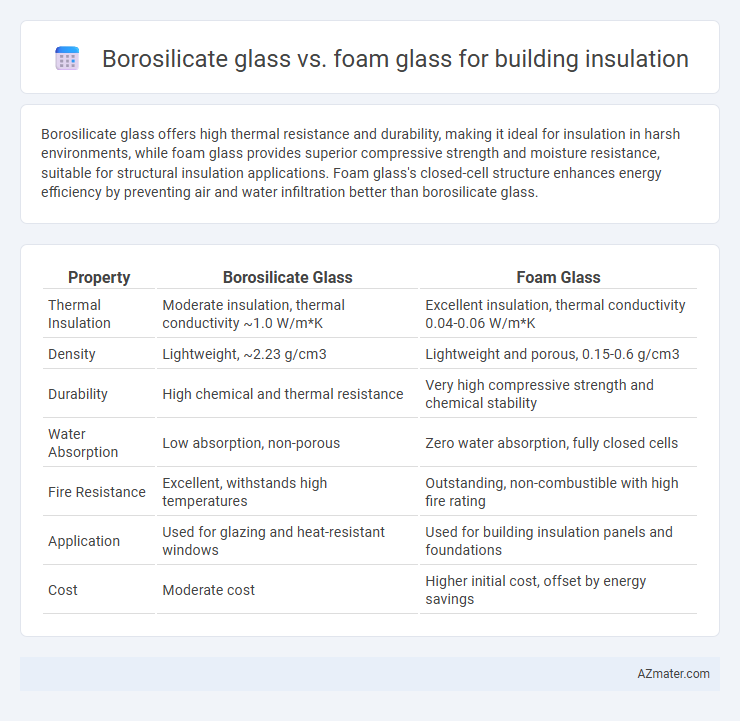Borosilicate glass offers high thermal resistance and durability, making it ideal for insulation in harsh environments, while foam glass provides superior compressive strength and moisture resistance, suitable for structural insulation applications. Foam glass's closed-cell structure enhances energy efficiency by preventing air and water infiltration better than borosilicate glass.
Table of Comparison
| Property | Borosilicate Glass | Foam Glass |
|---|---|---|
| Thermal Insulation | Moderate insulation, thermal conductivity ~1.0 W/m*K | Excellent insulation, thermal conductivity 0.04-0.06 W/m*K |
| Density | Lightweight, ~2.23 g/cm3 | Lightweight and porous, 0.15-0.6 g/cm3 |
| Durability | High chemical and thermal resistance | Very high compressive strength and chemical stability |
| Water Absorption | Low absorption, non-porous | Zero water absorption, fully closed cells |
| Fire Resistance | Excellent, withstands high temperatures | Outstanding, non-combustible with high fire rating |
| Application | Used for glazing and heat-resistant windows | Used for building insulation panels and foundations |
| Cost | Moderate cost | Higher initial cost, offset by energy savings |
Introduction to Borosilicate Glass and Foam Glass
Borosilicate glass, renowned for its high thermal resistance and low thermal expansion, is commonly used in building insulation to enhance energy efficiency and durability. Foam glass, made by foaming crushed glass with a foaming agent, provides excellent insulation due to its closed-cell structure, offering moisture resistance and fireproof properties. Both materials contribute to sustainable construction solutions, with borosilicate glass excelling in temperature stability and foam glass delivering superior compressive strength and environmental benefits.
Composition and Manufacturing Processes
Borosilicate glass insulation is composed primarily of silica and boron oxide, known for its low thermal expansion and high resistance to thermal shock, produced through melting and controlled cooling processes. Foam glass insulation is made by pulverizing recycled glass mixed with a foaming agent, then heating in a kiln to create a cellular, lightweight structure with excellent compressive strength. Manufacturing borosilicate glass involves precision melting at high temperatures (around 1400degC) to achieve chemical homogeneity, while foam glass production relies on foaming and sintering at approximately 800degC to develop its porous matrix ideal for thermal insulation.
Thermal Insulation Performance
Borosilicate glass offers excellent thermal insulation with low thermal conductivity around 0.12 W/m*K, making it highly efficient for heat resistance in building applications. Foam glass provides superior insulation due to its cellular structure, with thermal conductivity values as low as 0.04 W/m*K, significantly reducing heat transfer and improving energy efficiency. Compared to borosilicate glass, foam glass excels in thermal insulation performance, providing better energy conservation and insulation in construction.
Mechanical Strength and Durability
Borosilicate glass offers superior mechanical strength due to its high resistance to thermal shock and chemical corrosion, making it ideal for demanding building insulation applications. Foam glass provides excellent durability with its closed-cell structure that resists moisture, pests, and fire while maintaining compressive strength suitable for load-bearing insulation layers. Both materials are valued in construction, but the choice depends on specific requirements, with borosilicate glass favored for mechanical robustness and foam glass for long-term environmental resistance.
Moisture and Chemical Resistance
Borosilicate glass offers excellent chemical resistance and low water absorption, making it highly effective against moisture penetration in building insulation applications. Foam glass insulation provides superior moisture resistance due to its closed-cell structure, which prevents water ingress and resists chemical degradation. Both materials exhibit strong durability, but foam glass is particularly advantageous in environments with high humidity and aggressive chemical exposure.
Fire Safety and Temperature Stability
Borosilicate glass offers excellent fire safety due to its high melting point of approximately 820degC and outstanding thermal shock resistance, making it stable under rapid temperature changes. Foam glass insulation provides superior fire resistance as a non-combustible material with a melting point over 1200degC and inherent self-extinguishing properties, ensuring enhanced structural fire protection. Both materials exhibit high temperature stability, but foam glass's closed-cell structure also provides excellent moisture resistance and maintains insulating performance at elevated temperatures.
Environmental Impact and Sustainability
Borosilicate glass offers excellent thermal insulation and chemical durability with a relatively low environmental footprint due to its recyclability and long lifespan in building insulation applications. Foam glass insulation, made from recycled glass, excels in sustainability by providing high insulating value, moisture resistance, and full recyclability, significantly reducing landfill waste. Both materials contribute to energy efficiency, but foam glass's closed-cell structure enhances durability and environmental resistance, making it a superior sustainable choice for building insulation.
Cost Comparison and Economic Considerations
Borosilicate glass insulation generally incurs higher initial costs due to its specialized manufacturing process and superior thermal resistance properties, making it suitable for high-performance building applications. Foam glass insulation offers a more cost-effective solution with competitive thermal insulation values and excellent durability, often resulting in lower lifecycle costs due to minimal maintenance and moisture resistance. Economic considerations favor foam glass for budget-conscious projects with moderate insulation requirements, while borosilicate glass is preferred in scenarios demanding enhanced heat tolerance and long-term energy savings, despite higher upfront investment.
Applications in Modern Building Insulation
Borosilicate glass offers excellent thermal resistance and durability, making it ideal for high-temperature insulation applications in modern buildings, such as insulating windows and skylights. Foam glass excels in lightweight, moisture-resistant insulation for walls, roofs, and floors, providing effective thermal and acoustic barriers with high compressive strength. Both materials contribute to energy efficiency and sustainability in construction but serve distinct roles based on structural and environmental requirements.
Choosing the Right Insulation: Key Factors to Consider
Borosilicate glass offers superior thermal resistance and chemical durability, making it ideal for high-temperature building insulation applications, while foam glass provides excellent compressive strength and moisture resistance, suited for below-grade and structural insulation. When choosing the right insulation, factors such as thermal conductivity (Borosilicate: ~0.13 W/m*K, Foam glass: ~0.07 W/m*K), environmental exposure, load-bearing requirements, and installation conditions must be evaluated. Cost-effectiveness and sustainability considerations also influence the decision, with foam glass often preferred for recycled content and long-term performance in damp environments.

Infographic: Borosilicate glass vs Foam glass for Building insulation
 azmater.com
azmater.com